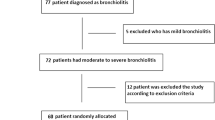Abstract
Purpose
It is not clear whether or not high-flow nasal oxygenation used in patients with severe respiratory tract infection, or coughing, increases the risk of infection to the healthcare personnel, and whether or not applying a surgical mask to the patient’s face or treating the patient in a negative-pressure room can reduce the risk.
Methods
In a randomized crossover design, we compared in 50 participants receiving high-flow nasal oxygenation, the aerosol counts measured at approximately 20 cm above the participant’s mouth in 32 different circumstances (with or without coughing, with or without wearing a surgical mask, at four different flow rates of oxygenation, in a positive- or negative-pressure operating room).
Results
In a positive-pressure room, a surgical mask significantly decreased the aerosol counts during coughing (P = 0.0005), or during no coughing (P = 0.009), under high-flow nasal oxygenation (at 60 l.min−1). In the negative-pressure room, the aerosol count was significantly lower than in the positive-pressure room, for all the circumstances (all P < 0.001), and a surgical mask significantly decreased the aerosol counts during coughing (P = 0.047) but not during no coughing (P = 0.60).
Conclusion
In conclusion, treating a patient in a negative-pressure room, or applying a surgical mask, during high-flow nasal oxygenation (with the flow rate of 60 l.min−1) would inhibit, but would not completely prevent, dispersion of aerosols by coughing.




Similar content being viewed by others
Data availability
The data that support the findings of this study are available from the corresponding author upon reasonable request.
References
Kim HJ, Asai T. High-flow nasal oxygenation for anesthetic management. Korean J Anesthesiol. 2019;72:527–47.
Li J, Jing GQ, Scott JB. Year in review 2019: high-flow nasal cannula (HFNC) oxygen therapy for adult patients. Respir Care. 2020;65:545–57.
Agarwal A, Basmaji J, Muttalib F, Granton D, Chaudhuri D, Chetan D, Hu M, Fernando SM, Honarmand K, Bakaa L, Brar S, Rochwerg B, Adhikari NK, Lamontagne F, Murthy S, Hui DSC, Gomersall C, Mubareka S, Diaz JV, Burns KEA, Couban R, Ibrahim Q, Guyatt GH, Vandvik PO. High-flow nasal cannula for acute hypoxemic respiratory failure in patients with COVID-19: systematic reviews of effectiveness and its risks of aerosolization, dispersion, and infection transmission. Can J Anaesth. 2020;67:1217–48.
Hui DS, Chow BK, Lo T, Tsang OTY, Ko FW, Ng SS, Gin T, Chan MTV. Exhaled air dispersion during high-flow nasal cannula therapy versus CPAP via different masks. Eur Respir J. 2019;53:1802339.
Leonard S, Strasser W, Whittle JS, Volakis LI, DeBellis RJ, Prichard R, Atwood CW Jr, Dungan GC 2nd. Reducing aerosol dispersion by high flow therapy in COVID-19: High resolution computational fluid dynamics simulations of particle behavior during high velocity nasal insufflation with a simple surgical mask. J Am Coll Emerg Phys Open. 2020;1:578–91.
McGrath JA, O’Sullivan A, Joyce M, Byrne MA, Li J, Fink JB, MacLoughlin R. In vitro model for investigating aerosol dispersion in a simulated COVID-19 patient during high-flow nasal cannula treatment. Front Med (Lausanne). 2022;9:1002659.
Matsui R, Sasano H, Azami T, Yano H, Yoshikawa H, Yamagishi Y, Goshima T, Miyazaki Y, Imai K, Tsubouchi M, Matsuo Y, Takiguchi S, Hattori T. Effectiveness of a novel semi-closed barrier device with a personalized exhaust in cough aerosol simulation according to particle counts and visualization of particles. Indoor Air. 2022;32: e12988.
Sakai W, Hasegawa G, Chaki T, Tachibana S, Yamakage M. Aerosol boxes decrease aerosol exposure only in depressurized rooms during aerosol-generating procedures in a simulation study. J Anesth. 2022;36:623–32.
Saito T, Asai T. Aerosol containment device for airway management of patients with COVID-19: a narrative review. J Anesth. 2021;35:384–9.
Saito T, Fujishiro A, Asai T. Aerosol extractor for airway management of COVID-19 patients. J Anesth. 2021;35:323.
Fujishiro A, Asai T, Saito T, Okuda Y. Efficacy of an aerosol suction device Free-100M in removing aerosols produced by coughing to minimize COVID-19 infection. J Anesth. 2023;37:196–200.
Kinoshita M, Ishikawa Y, Sekiguchi R, Matsuda M, Tanaka K. Impact of surgical masks on fraction of inspired oxygen during oxygen therapy depends on the type of oxygen masks and respiratory conditions: volunteer- and simulation-based studies. J Anesth. 2022;36:633–41.
Takazono T, Yamamoto K, Okamoto R, Morimoto S, Izumikawa K, Mukae H. Effects of surgical masks on droplet dispersion under various oxygen delivery modalities. Crit Care. 2021;27(25):89.
Li J, Alolaiwat A, Harnois LJ, Fink JB, Dhand R. Mitigating fugitive aerosols during aerosol delivery via high-flow nasal cannula devices. Respir Care. 2022;67:404–14.
Cohen J. The test that a proportion is .50 and the sign test. In: Statistical power analysis for the behavioral sciences. 2nd ed. New York: Psychology press; 1988. p. 145–178.
Winslow RL, Zhou J, Windle EF, Nur I, Lall R, Ji C, Millar JE, Dark PM, Naisbitt J, Simonds A, Dunning J, Barclay W, Baillie JK, Perkins GD, Semple MG, McAuley DF, Green CA. SARS-CoV-2 environmental contamination from hospitalised patients with COVID-19 receiving aerosol-generating procedures. Thorax. 2022;77:259–67.
Asai T. Pandemic and infodemic: the role of academic journals and preprints. J Anesth. 2023;37:173–6.
Author information
Authors and Affiliations
Contributions
All the authors contributed to the study conception and design, material preparation, data collection and analysis. WU, TS and TA drafted the first manuscript, and all revising it critically for important intellectual content. All agreed to be accountable for all aspects of the work in ensuring that questions related to the accuracy or integrity of any part of the work are appropriately investigated and resolved. All the authors read and approved the final manuscript.
Corresponding author
Ethics declarations
Conflict of interest
WU received Research incentive grant from Dokkyo Medical University. The other authors have no conflict of interests.
Additional information
Publisher's Note
Springer Nature remains neutral with regard to jurisdictional claims in published maps and institutional affiliations.
About this article
Cite this article
Ugajin, W., Asai, T., Saito, T. et al. Efficacy of a surgical mask during high-flow nasal oxygen therapy in preventing aerosol dispersion: a randomized controlled study. J Anesth 37, 787–793 (2023). https://doi.org/10.1007/s00540-023-03237-w
Received:
Accepted:
Published:
Issue Date:
DOI: https://doi.org/10.1007/s00540-023-03237-w




